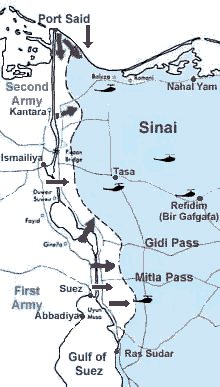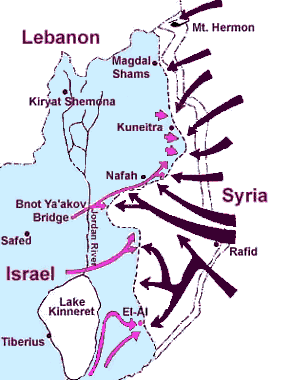Myths & Facts
By: Mitchell G. Bard
Chapter 8: The 1973 Yom Kippur War
MYTH“Israel was responsible for the 1973 War.”
|
| “All countries should wage war against the Zionists, who are there to destroy all human organizations and to destroy civilization and the work which good people are trying to do.” — King Faisal of Saudi Arabia 6 |
MYTH
“Egypt and Syria were the only Arab states involved in the 1973 war.”
FACT
At least nine Arab states, including four non-Middle Eastern nations, actively aided the Egyptian-Syrian war effort.
A few months before the Yom Kippur War, Iraq transferred a squadron of Hunter jets to Egypt. During the war, an Iraqi division of some 18,000 men and several hundred tanks was deployed in the central Golan and participated in the October 16 attack against Israeli positions.7 Iraqi MiGs began operating over the Golan Heights as early as October 8, the third day of the war.
Besides serving as financial underwriters, Saudi Arabia and Kuwait committed men to battle. A Saudi brigade of approximately 3,000 troops was dispatched to Syria, where it participated in fighting along the approaches to Damascus. Also, violating Paris’s ban on the transfer of French-made weapons, Libya sent Mirage fighters to Egypt.8
Syrian Minister of Defense Mustafa Tlas told the Syrian National Assembly in December 1973 of the following example of “supreme valor” by Syrian troops:
“There is the outstanding case of a recruit from Aleppo who murdered 28 Jewish soldiers all by himself, slaughtering them like sheep. All of his comrades in arms witnessed this. He butchered three of them with an ax and decapitated them. . . . He struggled face to face with one of them and throwing down his ax managed to break his neck and devour his flesh in front of his comrades. This is a special case. Need I single it out to award him the Medal of the Republic. I will grant this medal to any soldier who succeeds in killing 28 Jews, and I will cover him with appreciation and honor his bravery.” 9
Other North African countries responded to Arab and Soviet calls to aid the front-line states. Algeria sent three aircraft squadrons of fighters and bombers, an armored brigade and 150 tanks. Approximately 1,000–2,000 Tunisian soldiers were positioned in the Nile Delta. The Sudan stationed 3,500 troops in southern Egypt, and Morocco sent three brigades to the front lines, including 2,500 men to Syria.
Lebanese radar units were used by Syrian air defense forces. Lebanon also allowed Palestinian terrorists to shell Israeli civilian settlements from its territory. Palestinians fought on the southern front with the Egyptians and Kuwaitis.10
The least enthusiastic participant in the October fighting was probably Jordan’s King Hussein, who apparently had been kept uninformed of Egyptian and Syrian war plans. But Hussein did send two of his best units—the 40th and 60th Armored Brigades—to Syria. This force took positions in the southern sector, defending the main Amman-Damascus route and attacking Israeli positions along the Kuneitra-Sassa road on October 16. Three Jordanian artillery batteries also participated in the assault, carried out by nearly 100 tanks.11
Sources:
1 Newsweek, (April 9, 1973).
2 Chaim Herzog, The Arab-Israeli Wars, (NY: Random House, 1984), p. 230.
3 Herzog, p. 280.
4 Shlomo Aronson, “On Sadat’s Peace Initiatives in the Wake of the Yom Kippur War”; Mitchell Bard, Will Israel Survive, (NY: Palgrave, 2007), pp. 8–9.
5 Howard Sachar, A History of Israel: From the Rise of Zionism to Our Time, (NY: Alfred A. Knopf, 1979), p. 747.
6 Beirut Daily Star, (November 17, 1972).
7 Trevor Dupuy, Elusive Victory: The Arab-Israeli Wars, 1947–1974, (NY: Harper & Row, 1978), p. 462.
8 Dupuy, p. 376; Herzog, p. 278; Nadav Safran, Israel The Embattled Ally, (MA: Harvard University Press, 1981), p. 499.
9 Official Gazette of Syria, (July 11, 1974).
10 Herzog, pp. 278, 285, 293; Dupuy, p. 534.
11 Herzog, p. 300.





